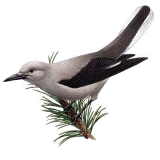Papers in the Biological Sciences
Document Type
Article
Date of this Version
2003
Abstract
Pigeons (Columba livia) searched for a goal location defined by a constant relative spatial relationship to 2 landmarks. For one group, landmark-to-goal bearings remained constant while distance varied. For another group, landmark-to-goal distances remained constant while direction varied. Birds were trained with 4 interlandmark distances and then tested with 5 novel interlandmark distances. Overall error magnitude was similar across groups and was larger than previously reported for Clark’s nutcrackers (Nucifraga columbiana). During training, error magnitude increased with interlandmark distance for constant-bearing but not constant-distance birds. Both groups searched less accurately along the axis parallel to landmarks than along the perpendicular axis. Error magnitude increased with novel extrapolated interlandmark distances but not with novel interpolated distances. Results suggest modest geometric rule learning by pigeons.



Comments
Published in Journal of Comparative Psychology 117:2 (2003), pp. 123-132; doi: 10.1037/0735-7036.117.2.123 Copyright © 2003 American Psychological Association. Used by permission. “This article may not exactly replicate the final version published in the APA journal. It is not the copy of record.” http://www.apa.org/journals/jcp/